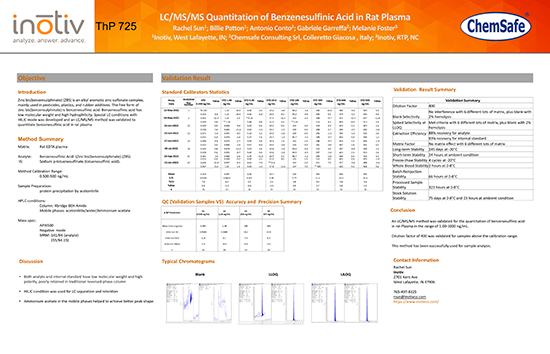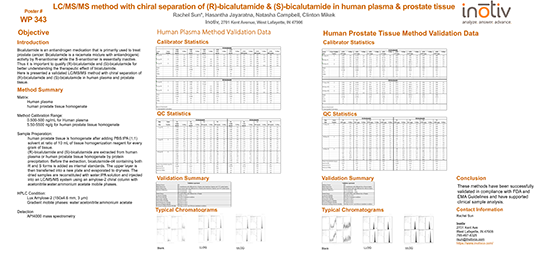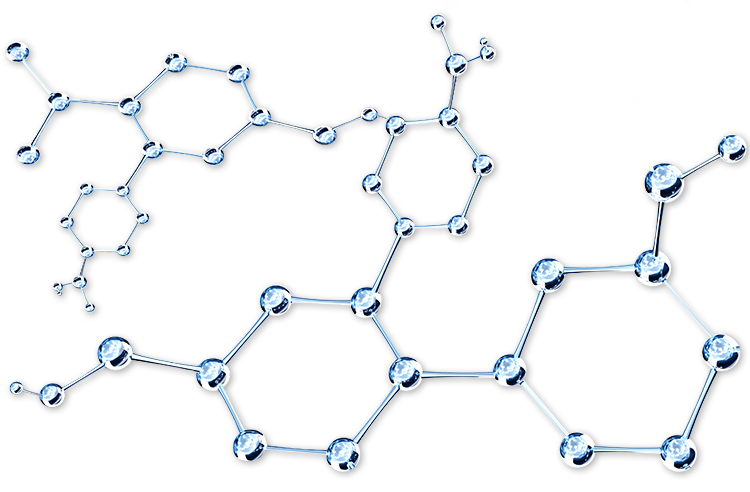Your Preclinical to Clinical
LC-MS Bioanalysis Division

Our pharmaceutical and bioanalytical team consists of Principal Investigators and Scientists who bring an average of 15+ years of experience. Our expertise comes from non-regulated and regulated bioanalysis with a focus on bioanalytical method development to accelerate your compound’s validation.
As your partner, you have full access to our bioanalysis lab and Sample Management team to support the analysis of your regulated or non-regulated studies. Our solution consists of fully compliant LC-MS services, a Metrology team who can support in-house mass spectrometry maintenance, and a Quality Assurance team with an impeccable 40+ year regulatory track record.

As a proud winner of the Frost & Sullivan 2022 North American Bioanalytical Testing Services Customer Value Leadership Award, we are committed to delivering more attention, more insight, and a superlative client experience to help you advance to your next milestone.

Pharmaceutical Capabilities
- Sample Management and Sample Storage
- Metrology and Instrument Qualification
- Dose Formulation Analysis (DFA)
- Stability Testing
- In Vitro Bioequivalence Analysis
- Bioavailability Analysis
Sample Analysis Types
- Bioanalytical Support for Domestic and International Studies
- Preclinical and Clinical Studies for Safety and Efficacy
- Immunogenicity
- Bioequivalence
- Toxicokinetics/Pharmacokinetics
- PhoenixTM WinNonlinTM
- Noncompartmental analysis
Speciality Compounds
- Small Molecules by LC-MS/MS
- Proprietary and Nonproprietary Drugs
- Prodrugs
- Insecticides
- Synthetic analogues
- Inhibitors
- Metabolites
- Chemotherapeutics
- Anesthetics
- Antiandrogens
- Hormones
- Immunosuppressives
- Vaccines
- Large Molecules or Biologics by LC-MS/MS
- Proteins
- Peptide(s)
- Oligonucleotides
- Nucleic acids
Sampling Techniques or Systems
- Microdialysate
- In Vitro:
- Hepatoc
- Media
Bioanalytical Methods List
Inotiv’s bioanalytical solution supports your program from preclinical research through clinical development. We are here to help you by delivering actionable insights with on-time results to move you to the next milestone. Our GLP nonproprietary methods have been validated in accordance with U.S. FDA Crystal City and current regulatory guidelines. You’ll benefit from our expert scientific team and state-of-the-art technologies to support your investigation into drug-drug interactions, concomitant drugs, and generics studies.
To talk to an expert about our nonproprietary methods, please click here.
Contemporary Platforms
- Liquid Chromatography, Tandem Mass Spectrometry
- AB SCIEX™ Platform (4000, 5500, 6500)
- Bio-Automation
- TomTec Quadra 96 Liquid Handling System
- TubeWriter™ 360
- SPEX SamplePrep 2010 Geno/Grinder Cell Lyser and Homogenizer
- HPLC and UPLC systems:
- Shimadzu Nexera®
- Agilent®
- Waters™
- CTC and Shimadzu Multi-Plate Autosamplers
- UV-Vis, fluorescence, electrochemical, charged aerosol detectors
- SpectraMax® M5 Microplate Readers (Vis, UV, Fl)
Information Systems
- Watson LIMS™ 7.7.1
- Projects Database System – Project Life Cycle Management
- Chromeleon™ Data Acquisition for HPLC
- Sciex Analyst®
- SoftMax® Pro GxP
- PerkinElmer® ELN
- MasterControl™ Document/Training Management System
- 21 CFR Part 11 Compliant
Biotherapeutic Development
Our experienced GLP team of bioanalysts utilize state-of-the-art molecular and cell-based platforms to support bioanalytical method development and validation. These methods to support the assessment of PK/toxicokinetic (TK)/pharmacodynamic (PD), immunogenicity, immunophenotyping, biomarkers, biosimilars, biobetters, gene therapy, vaccine endpoints, and analysis for other biotherapeutic programs.
To learn more about our Bioanalytical services supporting Biotherapeutic development, click here.
Rapid Discovery LC-MS Bioanalysis
Inotiv provides a fully integrated non-GLP bioanalytical drug discovery solution customized to your company’s project goals. We offer pharmacological and toxicological assessment across multiple therapeutic areas and species to ensure the right studies are performed at the right time.
Our discovery solution supports your therapeutic candidates with in vitro/in vivo DMPK, biology, PK, PD, and toxicology using high-throughput technology platforms. As your partner, you have access to unique insights that rapidly advance your discovery efforts for small molecule and biotherapeutic development.
To learn more about our Nonregulated Discovery Bioanalytical services, click here.
Scientific Publications
Frequently Asked Questions (FAQs) for Bioanalytical LC/MS
What is bioanalysis and why do I need it in drug development?
Bioanalysis is an area of analytical chemistry concerned with the quantitative measurement of a substance of interest extracted from biological samples, like blood, serum, tissue, plasma, or urine. These substances are often active pharmaceutical ingredients and/or their metabolites. Small molecules, biomarkers, therapeutic proteins, oligonucleotides, and peptides are popular analytes of interest that require detection to determine their concentrations at selected timepoints, and eventually their pharmacokinetic (PK) characteristics. These concentrations provide information on how the body impacts the drug and are useful when determining the efficacious range of the drug to achieve steady-state dosing for the treatment of a disease. Bioanalysis is also useful in confirming that a dose was absorbed by simply taking peak-and-trough sampling rather than a full PK profile.
What is the difference between Liquid Chromatography/ Mass Spectrometry (LC/MS analysis) and Immunoassays?
LC/MS Analysis utilizes the separation attributes of liquid chromatography (LC) and the power of the mass spectrometer (MS) to determine the concentrations of analytes of interest - sensitively and selectively - with great accuracy and precision. Conversely, while immunoassays also provide accurate and precise data and can be more sensitive for large molecules, they may not provide adequate specificity because ligand binding assays, or immunoassays, require the use of capture antibodies (i.e., anti-antibodies) or capture proteins which could have less than desirable specificity. While the most common format of immunoassays, the sandwich ELISA (Enzyme Linked Immunosorbent Assay), tends to be the go-to bioanalytical technique for large molecules, it is not used for small molecule analysis. LC/MS Analysis, however, is appropriate for both large- and small-molecule (about or less than 1,000 Daltons in molecular weight) bioanalysis.
WHAT IS A HYBRID ASSAY AND WHEN IS IT NEEDED?
During immunoassay method development for large molecule analysis, selectivity issues may arise that limit the sensitivity and specificity of the analyte of interest which can be resolved using LCMS separation and detection. The hybrid nature arises during sample preparation that is atypical for an LCMS workflow by employing immunoaffinity capture of the large molecule analyte to isolate it from the biological matrix. The additional separation by LC and then detection on the MS for a specific parent and daughter ion can resolve the selectivity issues and provide the sensitivity and specificity that the immunoassay was not able to achieve.
What is an internal standard and why is it important?
The internal standard (IS) is selected during the method development process. The purpose of the IS is to help monitor the sample to identify any fluctuation during extraction, autosampler injection volume, and most crucially, accounts for any matrix effect from individual samples during the ionization process. The preferred IS candidate is the stable-isotope-labeled (SIL-IS) version of the analyte. The SIL-IS is recommended because its structure is much closer to that of the main analyte’s structure providing similar behavior during the extraction and analytical procedure. Thus, the SIL-IS provides a more accurate evaluation of any fluctuation in the analytical process over an analogue IS candidate.
What is method development and validation?
Method development is the process of determining the appropriate extraction technique and LC/MS parameters (analytical method) for the specific compound matrix combination. Method validation is the process of running an analytical method through a series of experiments defined in the guidance to validate that the method will meet criteria sufficiently to analyze samples. It is required to develop and validate a method for analyte(s) in each matrix that it is going to be collected.
Method development and validation is a 6-to-8-week process for both pre-clinical and clinically regulated studies. We recommend having reference material shipped three months prior to the start of dosing. The ICH Guidance (see FAQ #3) requires a reference standard with a purity determination to support validation which upholds the foundation for regulated study sample analysis. The method development can be started with an unverified (without purity determination, etc.) batch to determine selectivity, potential sensitivity, and, most importantly, stability. Other parameters, such as calibration curve range, recovery, matrix effects, accuracy, and precision, are determined during the method development - the ultimate purpose of which is to prepare for the method validation.
Method validation will consist of three core runs, plus additional runs for needed validation experiments, the purpose of which is to determine the accuracy and precision of the method, as well as establish such stabilities as short-term stability (ambient or wet ice conditions necessary to the sample preparation duration), freeze/thaw cycling, post extraction stability, (under liquid chromatography (LC) autosampler conditions - to determine the limits of storage before injection) and long-term sample storage stability. Selectivities are evaluated with blank matrix quality control samples that are spiked into different lots of a matrix that represent different samples from different individual test systems of the same matrix type.
Once all the parameters (and more, depending on the needs of a particular study) are evaluated and fall within the M10 ICH Guideline acceptance criteria, a robust method is published and ready for use in analyzing regulated study samples.
What guidance do we follow and why?
Until 2022, there were multiple world heath authority guidelines - depending on country or region - that we would follow, and for a Contract Research Organization (CRO), all these guidelines are considered when writing standard operating procedures (SOPs). Currently, however, we follow the ICH Harmonized Guideline for Bioanalytical Method Validation and Study Sample Analysis M10, adopted on 24 May 2022.




